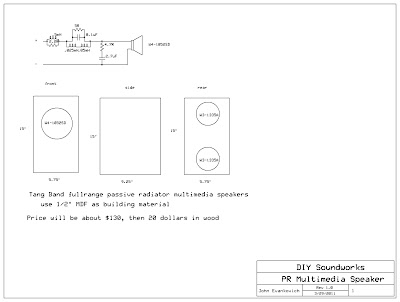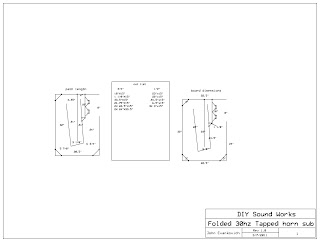I have decided to design an inexpensive, easy to build, compact, subwoofer-satellite speaker system using passive crossovers and a small amplifier built into the subwoofer cabinet. They use a single 3" driver per channel, and an 8" subwoofer to support the low end. They are all in a sealed configuration for the simplicity of construction, and superior impulse response to ported designs. These speakers have the capability to reach around 100 decibels, which is more than neccesary for computer speakers, which is a good thing, and all of this for $120 worth of parts, including an amplifier. The only other cost is a sheet of 1/2" or 3/8" MDF, and a finish of your choice. Which, depending on the finish, shouldn't cost very much, as the MDF will only be 12 to 15 dollars.
 |
| Fullrange |
 |
| Subwoofer |
The parts list for this particular project is fairly short and the construction is extremely simple, if you have a fair amount of common sense. I am going to assume that if you are reading this and are seriously considering building one of these speakers that you know how to measure and cut wood so that the inside dimensions are as shown in the schematic picture, however, I love to help, so if there are any questions please leave a comment and I will address the issue right away. But, after the construction of the three simple boxes, all that is left is to wire the crossover using your choice of board. It works fairly well to solder the components together and then simply glue them with hot glue to something and place it inside the cabinet, or use one of the common circuit boards with many holes pre-drilled in it. Those boards are available at Parts Express as well as Radioshack.
 |
| suggested amplifier |
The amplifier for this project is only if you do not have one already and is of decent quality for a computer audio system. The Crossovers for both the subwoofer and the satellites are located inside the subwoofer cabinet, therefore the amplifier should be connected directly to the subwoofer, then the crossover outputs on the subwoofer should be connected to the satellite speakers. I think I covered everything you need to know to build these there. Now for some technical information. The crossover between the sub and satellites is at 125hz, which is higher than optimal, but the best that can be done with such small drivers and still have decent output capability and distortion. The reason for not having a tweeter on the satellites is because I believe it to be unneccesary with the driver used. It has a frequency response that extends to 18khz, which is higher than most people over 20 can hear anyway. But, if you feel the need for a tweeter, you simply will need to add two more parts to the crossover. A capacitor on the tweeter as a highpass, and an inductor for the midwoofer as a lowpass. The crossover should be fairly low, so between 3khz and 4.5khz would be good. But some audiophiles believe that a point source loudspeaker has a property of musicality that is not found in multidriver speakers. There is an L-Pad that should be placed in the satellite crossover circuit to balance the output between the subwoofer and the satellites (wiring diagram shown below). The reason for this is that I designed the sub to have the same output as the satellites if placed under a desk, in the corner where your feet won't hit the cone, which puts it in 1 pi space. Simply meaning that extra reflections from being so close to walls adds about 6db of output. So if the subwoofer is used without being in a corner or under a desk you will need to attenuate the satellites slightly. Or if you prefer more bass.
 |
| How to wire an L-Pad |
The dimensions of the front of the satellites and the entire subwoofer cabinet are derived from the golden ratio of 1.618:1, which again, some audiophiles believe possess some unmeasurable property that makes the sound more musical. But, the reason given for this increase in fidelity is that there is reduced resonance within the cabinet, reducing unwanted noise from vibrating cabinet walls. which brings me to another point. the satellites will be perfectly fine with 1/2" or 3/8" MDF, but if using the same thickness of material for the subwoofer cabinet it should be braced. Simply cut strips of MDF about 2" wide and 7" long and glue them around the center of the cabinet, reducing the vibrations from the large front and rear panels.
Parts List
Capacitors
2x47uF
2x4uF
2x0.22uF
Inductors
2x0.4mH air core
2x5.0mH steel core
Resistors
2x2.4 Ohm
2x7.0 Ohm
1x15W Stereo L-Pad
Others
2xTang Band W3-1053SC
1x Parts Express 299-094 8" subwoofer
1x stereo amplifier - Recommended Lepai Tripath TA2020 (Parts Express 310-300)
6x Red binding post
6x Black binding post
(or replace binding posts with 6x Terminal plates or cups)
Any question? Please leave a comment if you do.















